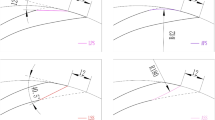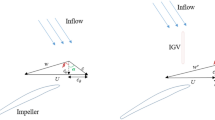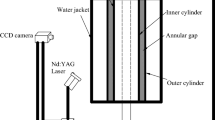Abstract
Acoustic impedance model of slits plays a crucial role in addressing noise reduction challenges in aircraft engines. To gain further insights into the sound absorption mechanisms of slits and to develop acoustic impedance model, this study investigates the bias flow effect on the acoustic impedance of compressor blade tip slit. The evolution of the blade tip leakage flow is calculated by the combination of two-dimensional discrete vortex model and one-dimensional acoustic propagation model. In this manner, the bias flow effects on the acoustic characteristics of the blade tip slits, such as slit impedance and sound absorption coefficient, are investigated. The model is validated through the experiment of bias flow effect on a circular orifice. It is further extended to calculate the flow field response of slits with different blade height and different aspect ratios. The results show that the acoustic impedance of equal area slits aligns closer with circular orifice experimental results than the acoustic impedance of equal width slits. Larger hub to shroud distances causes less influence on the blade slits of the same width. Increasing hub to shroud distance reduces the Ma of the maximum absorption coefficient. As aspect ratio increases, the acoustic reactance component corresponding to the acoustic mass of the slit decreases. Increasing the hub to shroud distance and increasing the aspect ratio of blade chord length to slit width can both improve the sound absorption under feasible conditions.















Similar content being viewed by others
Data availability
The data underlying this article will be shared on reasonable request to the corresponding author.
Abbreviations
- AR:
-
Aspect ratio of the blade chord length to the slit width
- h :
-
Distance of shroud to hub
- H :
-
Height of compressor blade
- u(z):
-
Complex velocity of vortices
- u*(z):
-
Conjugate complex velocity of vortices
- s :
-
Width of the compressor blade tip slit
- ρ :
-
Density of the air
- v :
-
Kinematic viscosity of the air
- Pcos(ωt):
-
Incident sound pressure of the blade tip slit
- ω :
-
Circular frequency of incident pressure
- P :
-
Amplitude of induced pressure
- t :
-
Physical time
- t v :
-
Existence time of vortices
- Δt :
-
Time step of the model
- z :
-
Complex coordinate of vortices in physical domain
- ζ :
-
Complex coordinate of vortices in calculation domain
- W :
-
Complex potential function of the flow field
- Γ:
-
Circulation of vortices
- u g :
-
Bias flow velocity through the slit
- Q :
-
Volume flux through the slit
- V av :
-
Average flow velocity through the slit
- r v :
-
Radius of vortex core
- b :
-
Length of blade chord
- A 0 :
-
Opening section area of the slit
- c :
-
Local sound speed
References
UnoIngard H (1967) Acoustic nonlinearity of an orifice. J Acoust Soc Am 42(6):17. https://doi.org/10.1121/1.1910576
UnoIngard H (1950) Acoustic circulation effects and the nonlinear impedance of orifices. J Acoust Soc Am 22(2):211. https://doi.org/10.1121/1.1906591
Powell A (1964) Theory of vortex sound. J Acoust Soc Am 10(1121/1):1918931. https://doi.org/10.1121/1.1918931
Howe MS (1997) Influence of wall thickness on Rayleigh conductivity and flow-induced aperture tones. J Fluids Struct 11(4):351–366. https://doi.org/10.1006/jfls.1997.0087
Rossiter JE (1966) Wind-tunnel experiments on the flow over rectangular cavities at subsonic and transonic speeds. R & M 5(7):78–81. https://doi.org/10.1016/S1532-0456(03)00006-1
Salikuddin M, Ahuja KK (1984) Acoustic power dissipation on radiation through duct terminations: experiments. J Sound Vib 91(4):479–502. https://doi.org/10.1016/0022-460X(83)90828-3
Tam CK, Pastouchenko NN, Jones MG et al (2014) Experimental validation of numerical simulations for an acoustic liner in grazing flow: Self-noise and added drag. J Sound Vib 333(13):2831–2854. https://doi.org/10.1016/j.jsv.2014.02.019
Dai X, Jing X, Sun X (2014) Acoustic-excited vortex shedding and acoustic nonlinearity at a rectangular slit with bias flow. J Sound Vib 333(13):2713–2727. https://doi.org/10.1016/j.jsv.2014.02.029
Parker R (1968) An investigation of acoustic resonance effects in an axial flow compressor stage. J Sound Vib 8(2):281–297. https://doi.org/10.1016/0022-460X(68)90233-2
Kaji S, Okazaki T (1970) Propagation of sound waves through a blade row II. Analysis based on the acceleration potential method. J Sound Vib 11(3):355, IN1-375. https://doi.org/10.1016/S0022-460X(70)80039-6
Ziada S, Oengoren A, Vogel A (2002) Acoustic resonance in the inlet scroll of a turbo-compressor. J Fluids Struct 16(3):361–373. https://doi.org/10.1006/jfls.2001.0421
Tam CK, Ju H, Walker BE (2008) Numerical simulation of a slit resonator in a grazing flow under acoustic excitation. J Sound Vib 313(3–5):449–471. https://doi.org/10.1016/j.jsv.2007.12.018
Yokoyama H, Kitamiya K, Iida A (2013) Flows around a cascade of flat plates with acoustic resonance. Phys Fluids 10(1063/1):4825376. https://doi.org/10.1063/1.4825376
Jing X, Sun X (2000) Discrete vortex simulation on the acoustic nonlinearity of an orifice. AIAA J 38(9):1565–1572. https://doi.org/10.2514/2.1178
Dai X, Jing X, Sun X (2015) Flow-excited acoustic resonance of a Helmholtz resonator: discrete vortex model compared to experiments. Phys Fluids 27(5):057102. https://doi.org/10.1063/1.4921529
Hofmans GCJ, Ranucci M, Ajello G et al (2001) Aeroacoustic response of a slit-shaped diaphragm in a pipe at low helmholtz number, 2: unsteady results. J Sound Vib 244(1):57–77. https://doi.org/10.1006/jsvi.2000.3458
Brown CE, Michael WHJ (1954) Effect of leading-edge separation on the lift of a delta wing. J Aeronautical Sci 11(2):54–60. https://doi.org/10.2514/8.3180
Dai X, Jing X, Sun X (2012) Vortex shedding and its nonlinear acoustic effect occurring at a slit. AIAA J 49(12):2684–2694. https://doi.org/10.2514/1.J051086
Kiya M, Sasaki K, Arie M (1982) Discrete-vortex simulation of a turbulent separation bubble. J Fluid Mech 120(1):219–244. https://doi.org/10.1017/S0022112082002742
Jing X (1999) Theoretical and experimental investigations of the sound vortex interaction occurred at a perforated plate dissertation, Beihang University
Hong Z, Fu Y, Chen L et al (2023) Experimental investigation on vortex sound interaction in self-induced acoustic resonance. J Sound Vib 548:117510. https://doi.org/10.1016/j.jsv.2022.117510
Acknowledgements
This investigation is supported by the National Natural Science Foundation of China (No. 51976116), the Open Research Subject of Key Laboratory of Aerodynamic Noise Control (No. ANCL20230201), and the National Science and Technology Major Project (No. J2019-II-0006-0026). The authors are grateful to Prof. Xiwen Dai for the discussion and comments.
Funding
National Natural Science Foundation of China, No. 51976116, Xiaohua Liu, Open Research Subject of Key Laboratory of Aerodynamic Noise Control, No. ANCL20230201, Xiaohua Liu, National Science and Technology Major Project, No. J2019-II-0006-0026, Xiaohua Liu.
Author information
Authors and Affiliations
Corresponding author
Ethics declarations
Conflict of interest
The authors declare that they have no conflict of interest.
Rights and permissions
Springer Nature or its licensor (e.g. a society or other partner) holds exclusive rights to this article under a publishing agreement with the author(s) or other rightsholder(s); author self-archiving of the accepted manuscript version of this article is solely governed by the terms of such publishing agreement and applicable law.
About this article
Cite this article
Lu, J., Liu, X. A theoretical model of the impedance at blade tip clearance in aeroengine compressor. AS (2024). https://doi.org/10.1007/s42401-024-00299-w
Received:
Revised:
Accepted:
Published:
DOI: https://doi.org/10.1007/s42401-024-00299-w




